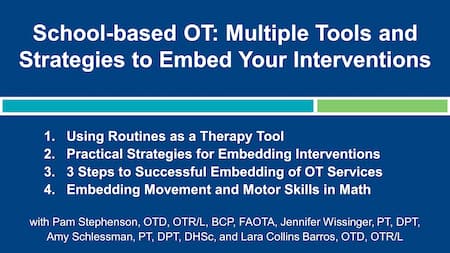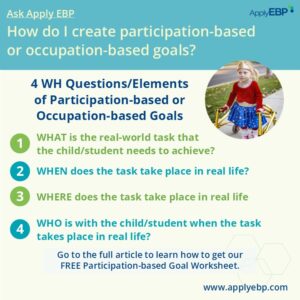Ask Apply EBP
4 Strategies to Include Children and Youth in Setting Their Goals
Q: How do I include students in setting their own IEP goals?
Current evidence shows that starting with a client-chosen goal is one of the key ingredients of effective intervention (Novak & Honan, 2019). So it’s great that you would like to involve them in setting their own IEP goals. As an added bonus, working on goals that are meaningful to them can be such a great motivator. Come to think of it, wouldn’t you prefer to work on your self-selected goal?
Here are 4 strategies to get you started:
Strategy #1: Use an Assessment Tool
There are some great assessment tools for goal setting. Below are 2 of our favorites:
-
-
- Canadian Occupational Performance Measure (COPM)
- Age: for 8-year-olds and older
- Cost: $15 for 100 online forms
- A semi-structured interview asking clients what they want to do, need to do, or are expected to do, but cannot do, do not do, or aren’t satisfied with how they do it. The goals are further rated in importance, their current performance, and their satisfaction with how they do it.
- Child Occupational Self-Assessment (COSA)
- Age: for 6- to 21-year-olds
- Cost$: 40 one-time fee for the PDF manual and forms that you can print out as many times as you want
- Consists of 25 items about everyday activities at home, in school, and in the community. You can add more items as appropriate.
- I call this the younger sibling of the COPM as it is more kid-friendly and easier to administer. There are 3 versions:
- Rating Form without Symbols
- Rating Form with Symbols (smiley/sad faces and stars)
- Card Sort Version – the easiest version. You show the child one activity card at a time and ask the child to rate their competence in performing the task and the importance of the task to them
- Canadian Occupational Performance Measure (COPM)
-
Important Note: Just because these tools have “occupation” in their name, it does not mean that they are just for OTs. They can be used by PTs, SLPs and others.
Strategy #2: Review with the Student Their Own IEP
Help the student understand what an IEP is. Then review their own IEP together. As you go through the goal page, ask them how they think they have done so far on their goals. Then help them create goals that are meaningful to them. What would they like to learn? What would they want to be better at?
Don’t want to reinvent the wheel? You can also find some IEP teaching resources online such as:
-
-
- A Student’s Guide to the IEP by LD Online
- It’s All About Me: Understanding My IEP by www.imdetermined.org
- SeekFreaks IEP Checklist: Student Version by Laurie Ray, MPT, PhD
-
Strategy #3: Conduct a Routine-based Conversation
Interview the student and ask them what they do in a typical day. One great suggestion from Jennifer Wissinger’s “Using ‘Routines’ as a Therapy Tool” seminar is to not use the word “routine”. The student might think their life does not necessarily have a set “routine”!
Instead ask them about what they do during various times of the day, such as morning arrival, a particular class they are having difficulties in, lunchtime, or recess. You can also narrow down the conversation to the times of day that you already know they have difficulties in based on reports from educators and/or parents. In the case of the latter, don’t forget to ask them about any other times of the day they find challenging that you have not yet discussed.
As you learn about their “time of day” activities, ask them what they find challenging, or where they would like to see themselves improve in. Is it putting their jacket on so they can head to lunch with their peers? Is it keeping up with their peers in recess? Is it completing school work in a particular class?
Strategy #4: Use Your Keen Observation Skills
For some of our clients, asking them directly about their goals is not an option. For example, in children with complex disabilities or in younger children that cannot communicate their goals eloquently.
For them, use your keen observation skills (and adult interviewing skills) to find out tasks that the student is initiating, trying to modify, or are showing an interest in doing, but is having difficulty doing (this strategy is included in Context-Focused Intervention Approach, more discussion on that here).
Try to find out the student’s preferred activities, and use it as a strength and motivator. Incorporate these activities into their goals to make the IEP goals even more meaningful to the student.
Final Words
There are many more strategies out there, so add in the comment below any ideas you may have.
Remember that including them in setting their goals is a great starting point. The next step is to make the goals easy to monitor by the student, their teacher, or anybody else in the team. You can learn how to do this in:
Peggy and Carlo’s 5 Tips and other strategies in their course: Creating Goals that Are Easy to Monitor. Take Peggy’s on-demand webinar, or the live 1-day version with lots of hands-on and discussions.
Creating Goals: Live in Peoria, IL
Creating Goals: 1.5-hour webinar

Curious what goals children typically come up with? Read “If Asked, What Goals Would Children Come Up With?“
Find More Answers to Your Questions in Our...
Featured School
Symposium
Featured Live
Workshop
Featured On-Demand
Webinar
5 Steps of Collaborative Goal Writing
Featured Webinar
Bundle
School-based OT: Embedded Interventions Bundle
Have a question?
Submit here…
*Clicking submit will send your question directly to our email inbox. Your name and email will let us know that your submission is real (not spam). We will not include these in our posts, unless you tell us to include your name. Please read our privacy policy here.
All infographics and videos on www.applyebp.com are intellectual properties of Apply EBP, LLC
You may use the infographics and videos for free for any non-commercial, educational purposes. Please cite the source as “Apply EBP, LLC” and a link to the source article. If you plan to use any infographic or video for commercial purposes (i.e., for profit), please email Carlo@applyebp.com to obtain a written permission. Permission can be granted on a case-by-case basis.











